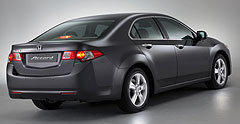Future models - Honda - Accord EuroFirst look: Honda presents all-new Accord EuroSimilar, but bigger: Redesigned medium sedan grows in most directions. More power and safety systems for next-generation Honda mid-sizer14 Feb 2008 HONDA’S new-generation Accord Euro has broken cover ahead of its Geneva motor show debut next month, in both sedan and wagon form. Due for release in Australia in the third quarter, the latest Honda mid-sizer looks similar to the outgoing model but is, in fact, all-new and somewhat larger than the popular current model. Honda describes the new Accord’s styling as an evolution of the current model, although it is significantly wider and slightly lower than its predecessor, adopting a ‘sharp-edged’ design with muscular wheel arches to emphasise the car’s wider track. The company says the more sporty approach to exterior design is best expressed in the new wagon, called the Tourer, with a mix of curves and crisp lines at the rear that give it a more stylish overall appearance. Although the previous Tourer was not sold in Australia, a Honda Australia spokesman said that the new generation wagon in under consideration for this country. Three Euro V emissions-compliant engines are offered in Europe and two of those are in the mix for Australia – a development of the current 2.4-litre petrol engine and a new 2.2-litre turbo-diesel – but not the entry-level 2.0-litre petrol. The uprated 2.4-litre petrol develops 147kW of power at 7000rpm (up from 140kW currently) and 233Nm of torque at 4500rpm (up from 223Nm), which should ensure it copes with the extra weight of the bigger body. Honda’s engineers gained the extra power by increasing the compression ratio from 10.5 to 11.0:1, fitting larger valves, revising valve timing and reducing exhaust system pressures. The second-generation Honda diesel engine goes by the name of i-DTEC and replaces the previous i-CTDi unit. It produces 110kW at 4000rpm and 350Nm at 2000rpm.  Employing the latest piezoelectric multi-stage fuel injection technology, more efficient exhaust gas recirculation and a particulate filter for significantly reduced emissions, the new engine is claimed to be not only cleaner but also quieter and smoother to drive. Employing the latest piezoelectric multi-stage fuel injection technology, more efficient exhaust gas recirculation and a particulate filter for significantly reduced emissions, the new engine is claimed to be not only cleaner but also quieter and smoother to drive.Both engines are mated to a six-speed manual gearbox, with a shift indicator light in the centre of the rev counter to advise the driver of the optimum point (in terms of best fuel economy) at which to change gear. Honda claims fuel savings of up to five per cent by following these commands. A five-speed automatic is offered with the 2.4 while an auto for the diesel will be launched in early 2009. Honda says it used the BMW 3 Series as a benchmark in development “to create a more involving, communicative drive” and claims greater agility than the current model. A lowered centre of gravity, a wider track, the all-new front double wishbone and rear multi-link suspension with variable rate dampers, and greater body rigidity reportedly result in more responsive handling and reduced body roll. Speed-sensitive electric power steering is standard, with a quicker steering ratio and using a new ‘axial’ brushless motor system that is said to provide better feel at higher speeds. Honda says the interior is more driver-focused, with a dashboard that extends from the centre console to sweep around the front seats, creating a cockpit-like feel. The extra width of the car has allowed this without intruding on driver or passenger space. The dash itself features ‘floating’ backlit instruments, with an LCD multi-information display contained within the centre of the speedo and steering wheel controls to allow the driver to cycle through the display screens. A new feature is a BMW-style service reminder that presents the driver with either the distance or days remaining to a required service, with an enlarged warning symbol appearing when the due date is imminent. The front seats have larger bolsters while a new internal structure is designed to reduce the transmission of vibrations. A familiar Honda three-spoke multi-function steering wheel is adjustable for both reach and rake, with an extra 10 degrees of tilt adjustment compared to the previous Accord Euro. As well as standard electronic stability control, an optional active system called Motion Adaptive EPS is available that “automatically initiates steering inputs aimed at prompting the driver to steer in the correct direction”. Honda says the steering input is barely noticeable and control of the steering remains with the driver, but that this supporting steering torque is enough to prompt the driver to act intuitively to regain stability or to shorten braking distances. Other safety highlights include radar-based adaptive cruise control, a camera-based lane-keeping system, a new pre-collision braking system and a trailer stability assist program that controls the engine and brakes to regain control if snaking should occur while towing. Read more:First look: Honda reveals its Euro vision |
Click to shareHonda modelsResearch Honda Motor industry news |














Facebook Twitter Instagram